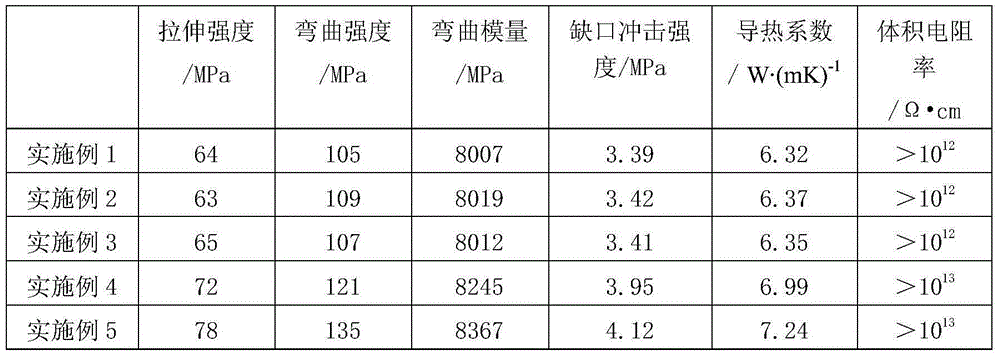Preparation method of thermal conductive electrical insulating material
A heat-conducting insulating material, high-density polyethylene technology, applied in the direction of organic insulators, plastic/resin/wax insulators, etc., can solve the problems of reduced product efficacy and shortened life, and achieve good mechanical properties and good thermal conductivity.
- Summary
- Abstract
- Description
- Claims
- Application Information
AI Technical Summary
Problems solved by technology
Method used
Image
Examples
Embodiment 1
[0017] A method for preparing a thermally conductive insulating material, comprising the steps of:
[0018] Step 1, in parts by weight, take 20 parts of high-density polyethylene, 10 parts of linear low-density polypropylene, 4 parts of nitrile rubber, 1 part of dibutyl sebacate, 2 parts of ethyl acetoacetate, two parts of methacrylic acid 1 part of methyl amino ethyl ester, 3 parts of polyamide resin, 2 parts of polyvinyl acetate, 2 parts of hydroxyl silicone oil, 1 part of talcum powder, 2 parts of stearic acid, 3 parts of alumina fiber, 1 part of coupling agent KH-5501, Heat and stir to mix;
[0019] Step 2, ball milling and drying the mixed material obtained in step 1 to obtain a dried product;
[0020] Step 3, add the dried product obtained in step 2 into a twin-screw extruder, extrude, granulate, and cool to obtain.
[0021] In step 1, the heating temperature is 50° C., and the stirring speed is 400 rpm.
[0022] In step 3, the extrusion temperature of the twin-screw ...
Embodiment 2
[0024] A method for preparing a thermally conductive insulating material, comprising the steps of:
[0025] Step 1, in parts by weight, take 23 parts of high-density polyethylene, 17 parts of linear low-density polypropylene, 6 parts of nitrile rubber, 2 parts of dibutyl sebacate, 4 parts of ethyl acetoacetate, two parts of methacrylic acid 5 parts of methyl amino ethyl ester, 5 parts of polyamide resin, 5 parts of polyvinyl acetate, 6 parts of hydroxyl silicone oil, 3 parts of talcum powder, 4 parts of stearic acid, 7 parts of alumina fiber, 3 parts of coupling agent KH-5503, Heat and stir to mix;
[0026] Step 2, ball milling and drying the mixed material obtained in step 1 to obtain a dried product;
[0027] Step 3, add the dried product obtained in step 2 into a twin-screw extruder, extrude, granulate, and cool to obtain.
[0028] In step 1, the heating temperature is 65° C., and the stirring speed is 300 rpm.
[0029] In step 3, the extrusion temperature of the twin-sc...
Embodiment 3
[0031] A method for preparing a thermally conductive insulating material, comprising the steps of:
[0032] Step 1, in parts by weight, take 30 parts of high-density polyethylene, 20 parts of linear low-density polypropylene, 7 parts of nitrile rubber, 5 parts of dibutyl sebacate, 5 parts of ethyl acetoacetate, dimethacrylate 6 parts of methyl amino ethyl ester, 7 parts of polyamide resin, 6 parts of polyvinyl acetate, 7 parts of hydroxyl silicone oil, 5 parts of talcum powder, 6 parts of stearic acid, 8 parts of alumina fiber, 3 parts of coupling agent KH-5503, Heat and stir to mix;
[0033] Step 2, ball milling and drying the mixed material obtained in step 1 to obtain a dried product;
[0034] Step 3, add the dried product obtained in step 2 into a twin-screw extruder, extrude, granulate, and cool to obtain.
[0035] In step 1, the heating temperature is 65° C., and the stirring speed is 300 rpm.
[0036] In step 3, the extrusion temperature of the twin-screw extruder is...
PUM
 Login to View More
Login to View More Abstract
Description
Claims
Application Information
 Login to View More
Login to View More - R&D Engineer
- R&D Manager
- IP Professional
- Industry Leading Data Capabilities
- Powerful AI technology
- Patent DNA Extraction
Browse by: Latest US Patents, China's latest patents, Technical Efficacy Thesaurus, Application Domain, Technology Topic, Popular Technical Reports.
© 2024 PatSnap. All rights reserved.Legal|Privacy policy|Modern Slavery Act Transparency Statement|Sitemap|About US| Contact US: help@patsnap.com








